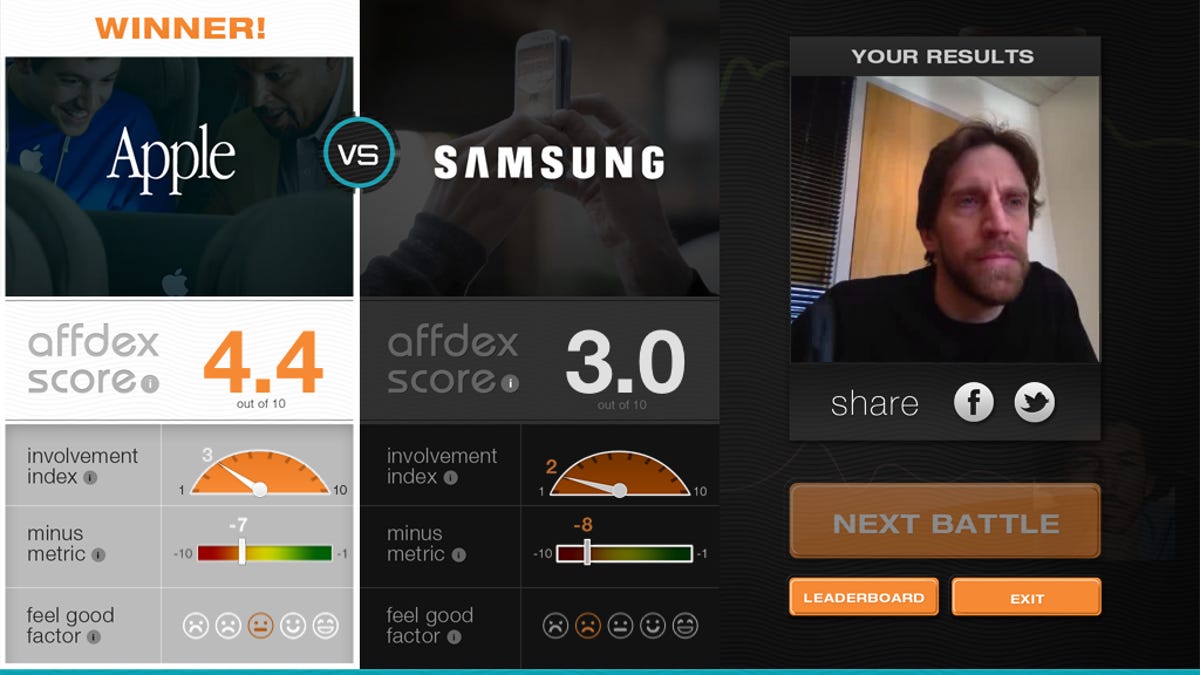Building better Super Bowl ads by watching you watch them
A 3-year-old company takes technology from MIT's Media Lab and applies it to ad testing. But do you like Yetis with your Wheat Thins?

WALTHAM, Mass.--The makers of Wheat Thins cereal may have a hit Super Bowl commercial on their hands.
I believe this because I watched the ad on my computer while another computer watched me watching it over the Internet. The ad combined a box of Wheat Thins, night vision goggles, fear of Bigfoot when there should have been fear of the Yeti, and a thieving neighbor. It seems my "emotional valence" score -- which can be roughly translated to mean my overall emotional reaction -- while watching all this was unusually high, at least once the Yeti and the the thieving neighbor made their appearance.
I had no idea a Yeti and Wheat Thins were a powerful combination, but after running the ad through a Web demonstration by the 3-year-old company Affectiva, I'm forced to conclude that's the case.
Welcome to the future of advertising, where the wisdom of spending a reported $4 million for a 30-second spot in the Super Bowl doesn't have to be left to the imagination of an ad agency's creative team and the honesty of focus groups.
When you turn on the the Super Bowl tomorrow and watch that game within the game -- no, not Beyonce's performance, I mean the ads -- there's a good chance that at least several of those pieces have been tested using Affectiva's tools, which are being used by both Coca-Cola and Unilever, which owns brands ranging from Dove soap to Ben & Jerry's ice cream. Using a Web camera and with a user's permission (usually commissioned by an ad agency or research firm), Affectiva monitors a person's expressions while watching an ad.
Affectiva provides a topline measurement on a scale from 1 to 10 on something the company calls an Affdex score. That's a combination of involvement, a "feel good" index, and a "minus metric." Behind that, reaction over the length of the ad is monitored and charted. When did someone smile during the ad? When did they frown? When did they drift? It's all tracked and produced on tables.
There's deep science behind that report. Affectiva was founded in 2009 and is based on technology created at the Massachusetts Institute of Technology's Media Lab. The technology was originally intended to work with people who have autism. Because people with autism may have difficulty displaying emotional reactions, co-founders Rana el Kaliouby and Rosalind Picard created a mathematical model for monitoring hard-to-perceive changes in their expressions.
"I personally think it could be a standard for advertising," said Stephanie Tilenius, an executive-in-residence at the venture capital firm Kleiner Perkins. Kleiner was part of a $12 million Series C funding round announced in August. The company was also a big attention-grabber at last month's Consumer Electronics Show in Las Vegas.
If you have a Webcam on your computer, you can run through the Affectiva demonstration yourself right here. You can also test a goat-related ad from Doritos (really, it kind of works), a Hyundai ad with a "don't tell mom" theme, and an already somewhat controversial ad from Volkswagen in which lots of people whom you wouldn't expect to have Jamaican accents sound a lot like Jimmy Cliff.
The first, most viable application for the Affectiva technology was in advertising, of course. But it could one day find its way into everything from medical devices to smartphones. Imagine, for example, if your phone could sense by your expression, pulse, and tone of voice how urgently you need an app or to make a phone call?
Affectiva made a splash after last year's Super Bowl with a public analysis of many of the ads shown during the Giants-Patriots nail-biter. Perhaps their most interesting conclusion was that the follow-up ad to 2011's hit "Vader kid" ad from Volkswagen did not test well among 400 participants. The ad involved a dog trying to lose weight and finally chasing a new, red Volkswagen. But when the ad transitions to a scene from Star Wars' cantina scene (a nod to the Vader kid), interest fell off the map and didn't recover.
Most likely, the ad testing technology will be used in addition to traditional ad testing, rather than replacing focus groups, said Graham Page, an executive at the market research firm Millward Brown. Last year, Millward Brown tested over 400 ads using the Affectiva technology and should use it for more than "several thousand" ads around the world this year.
A tour of Affectiva's technology is a bit of a tour of your own instincts. In seconds, you can see quantified what you already suspected about an ad. In a face-to-face test of Apple and Samsung pieces, for example, neither ad exactly floated my boat. (You can see my overly stern expression while watching them in the screenshot above this article.)
So what else did I learn about my advertising tastes? It appears I really hate commercials in which grown men act like children but I am a hopeless sucker for ads with real children. I've always sort of known this. But thanks to a demonstration of facial-tracking technology here at the offices of a young company called Affectiva I can say, with certainty, that, yes, Verizon, I was seriously annoyed by that dopey ad with the dopey guys playing basketball. But the kids in the AT&T ad? Adorable.
"Your negative reaction to that," said Avril England, vice president of product management and marketing at Affectiva, "was about as negative as it can get."

